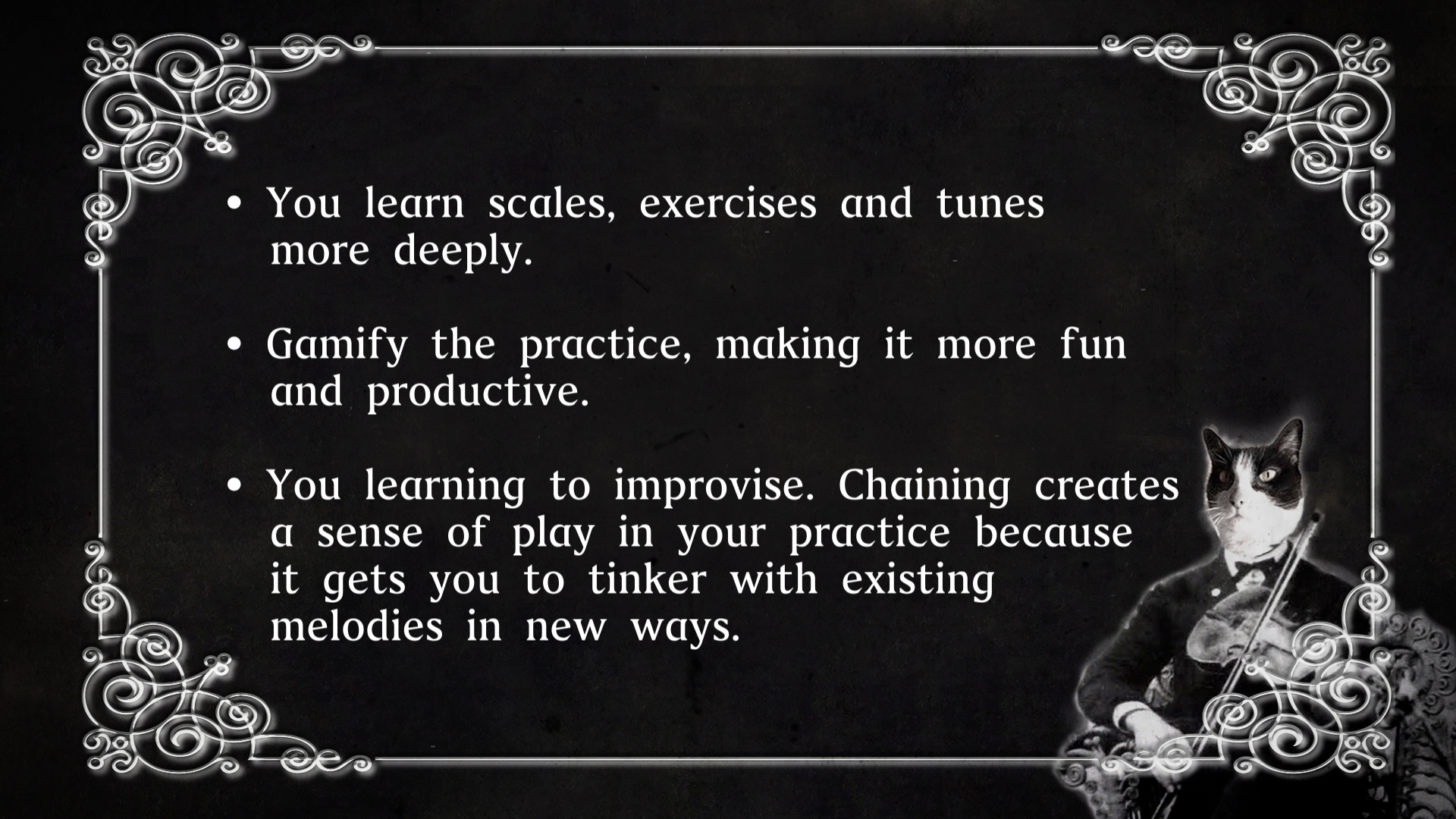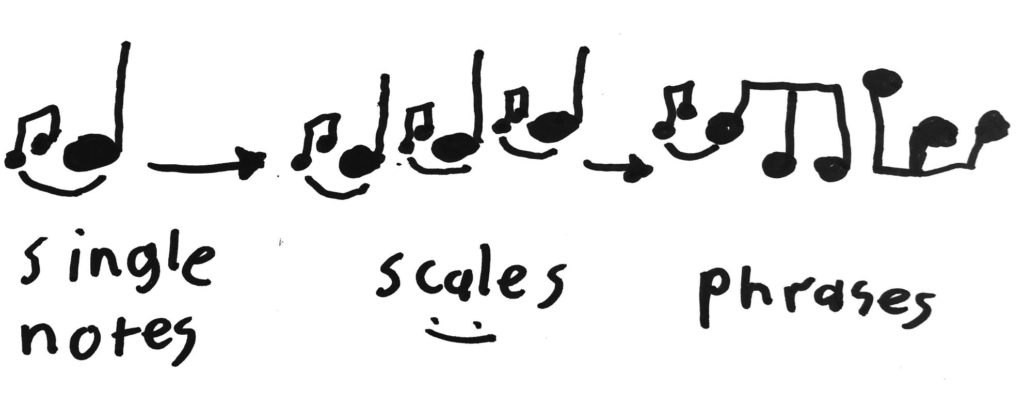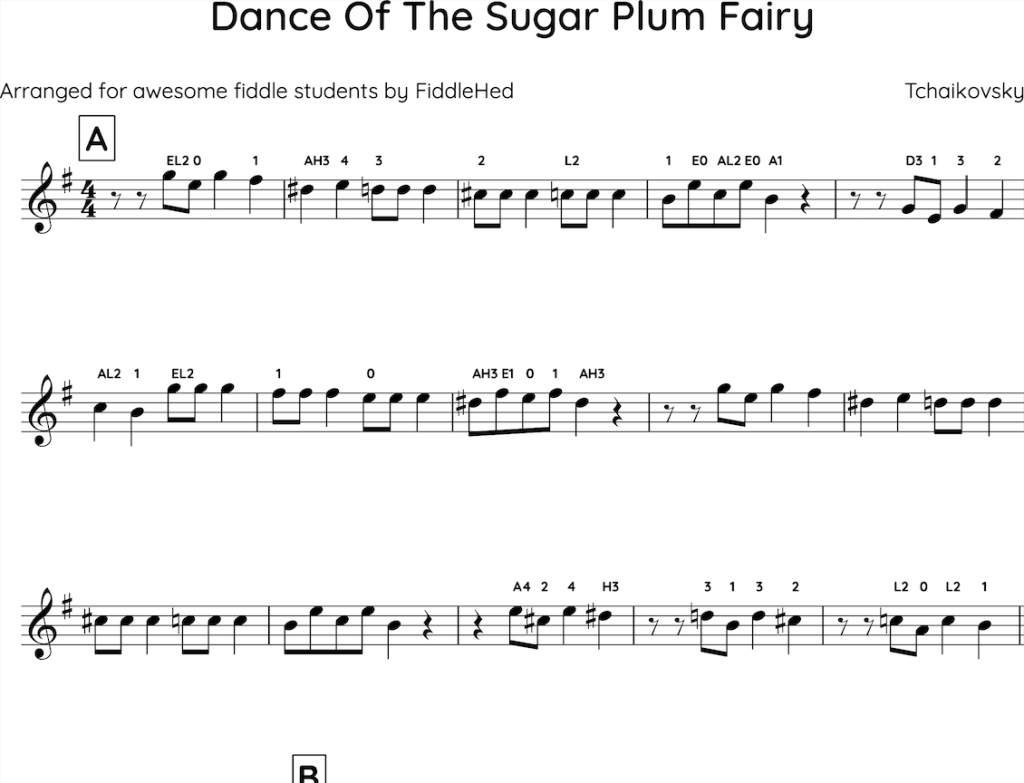Here’s a practice technique called “Chaining”. The basic idea is to incrementally add to what you are practicing. You can slowly piece together notes to create scales and tune phrases. Then you can piece together tune phrases to build out tunes. You can even chain tunes to create sets and medleys.
Here’s why this practice tool is a good idea:

Let’s go more into it…
Chaining scales
Let’s start simply by chaining single notes into a scale.
Play the first note of a scale, then play the first two notes, etc., until you have the whole scale.
For D Major scale, the sequence would be:
D0, D0-1, D0-1-2, D0-1-2-3, D0-1-2-3-A0, D0-1-2-3-A0-1, D0-1-2-3-A0-1-2, D0-1-2-3-A01-2-3

That’s an example of Forwards Chaining. We can also practice Backwards Chaining:
A3, A3-2, A3-2-1, A3-2-1-0, etc.

We can practice Forwards and Backwards Chaining with each repetition. I learned this on my trip to India. For example:
D0, D0-1-0, D0-1-2-0, D0-1-2-3-2-1-0, etc.

Or Backwards and Forwards Chaining:
A3, A3-2-3, A3-2-1-2-3, A3-2-1-0-1-2-3
You can practice this with any scale, exercise or piece of a tune.
Chaining larger chunks

If you’ve already learned a tune, then you can chain together bigger chunks to help you practice it more deeply and remember it.
For example, with the tune Arkansas Traveller, we can play the first quarter, then the first two quarters. Etc. This is Forwards Chaining.

⬇️

⬇️

⬇️

To practice Backwards Chaining on a tune, start with the fourth quarter, then play the third and fourth quarters, etc. Play around with different ways you can chain things. For example, you could start on bar 3, add bar 4, then add bar 2, then add bar 5, then bar 1 etc.
Use Chaining to learn longer pieces
You can use combination of backwards chaining to learn longer pieces which are not as repetitive as fiddle tunes. Let’s use the A part of Dance Of The Sugar Plum Fairy as an example:

Learn the first bar well. Then learn the second bar. Then, backwards chain the first and second bars. Then learn the third bar. Then backwards chain the third and second bar. If you can do that, then backwards chain the first three bars.
Continue to learn the tune in this way. If you find that you have trouble playing everything you’ve learned, simply reduce the length of the chain.
Integrate new pieces with chaining
What’s great about Chaining is that you learn to integrate smaller practice bits into a larger whole.
This helps you to learn longer pieces of music. The smaller chains build your confidence. They help you to play the music with flow.
If you can play a small piece and build a larger piece from that, then you’ll know the tune more deeply.
The goal is to play larger chains with the same sense of ease and flow that you play smaller chains.
Hear a piece of music in a new way
The length of the chain changes your perception of the music. This makes practice more interesting. It also stimulates the creative process.
Create chains of different links to create new melodies from tunes you’ve learned. This can be helpful when you’re searching for improvisation ideas.💡


Neat…you sort of do that with piano, too, don’t you? Great stuff!
Hi Susieq, yes good point. Other instruments can work great with these types of exercises, like piano 🎹 Glad to hear you enjoy!
This is suddenly a really hard tune out of the blue! Good thing I can read sharps and naturals – otherwise it would be a total loss without even a sound bite as a guide. I will keep at it though. Your lessons are really awesome and I am learning a lot.
Thanks for sharing, Catherine. Your motivation in the challenge is great to experience. Thanks for your interest in the program!
Simplifying more than I originally think or plan to always helps me with trickiness.
Thank you so much. This is going to be very helpful in both this course and my private lessons. Learning a rather tricky piece right now, but applied chaining and it’s actually coming together.
That’s awesome. Denise. Thanks for giving insights on your experience with this. Simple practise tools that we can get familiar with and utilize wherever 🙂 🎶
Bro I wish this was earlier in the course! I’ve always struggled with putting the individual quarters together and with being too dependent on playing through from the very beginning (i.e., if I mess up I have to start all over). I will definitely use this technique!
Really good tool to master using it a lot.
I like this a lot. From an Alexander Technique teacher point of view it removes the “end-gaining” element and allows me to enjoy the “journey itself” Thank you!
Great lesson makes thing fun and makes the mind wonder into new music and growth…